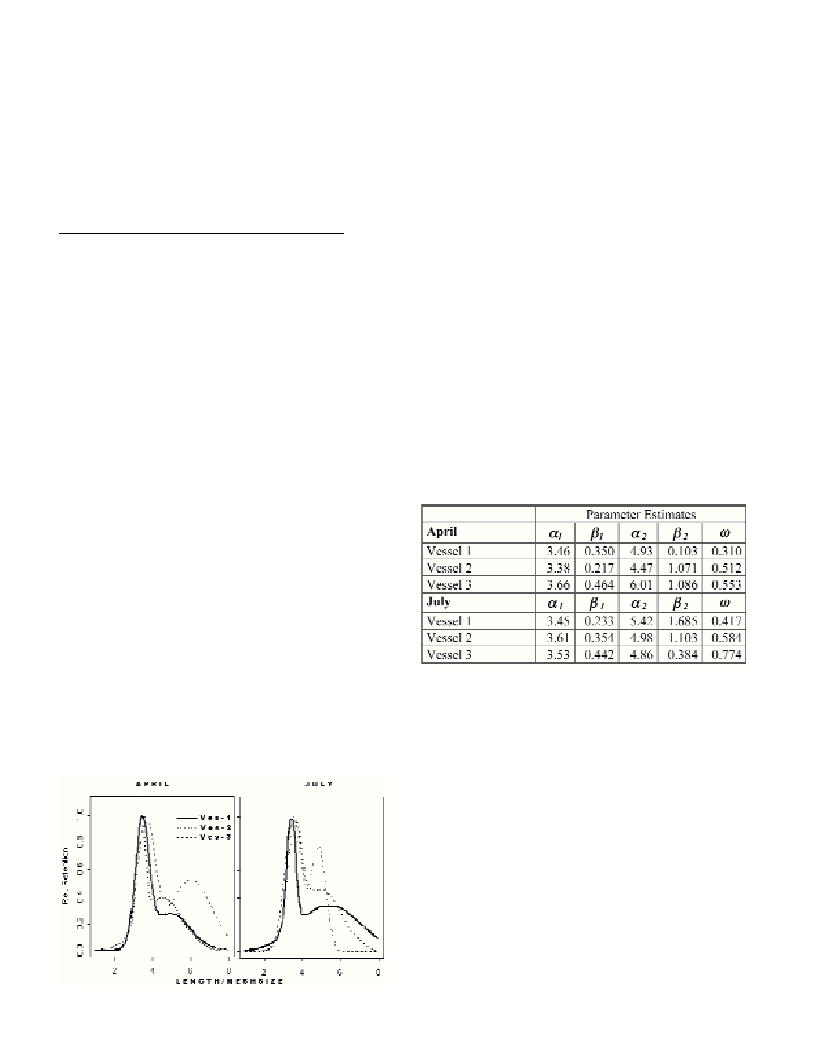SIZE SELECTIVITY OF TRAMMEL NETS USED IN THE COMMON SOLE, SOLEA SOLEA,FISHERY
IN THE THRACIAN SEA (NE MEDITERRANEAN).
A. Adamidou
1
*, A. Kallianiotis
1
, R. Holst
2
1
Fisheries Research Institute, NAGREF, 64007 N. Peramos, Kavala, Greece - * fri@otenet.gr
2
ConStat, Groenspaettevej 10, DK-9800 Hjoerring, Denmark - rene@constat.dk
Abstract
The size selectivity of trammel nets used in the Thracian Sea (Greece) sole fishery was estimated using catch-at-length data from five mesh
sizes (44, 56, 68, 84, 110 mm full mesh). Selectivity of nets and variation between vessels were calculated using standard selectivity
software. The bi-modal curve provided the best fits. The modal length for largest retention was 3.5 times mesh size. The optimum mesh
sizes were compared to commercial practice. No significant difference between the vessels’fishing efficiency was shown.
Keywords: Selectivity; Trammel net; Solea solea, Greece
Rapp. Comm. int. Mer Médit., 37,2004
303
Introduction
The common sole, Solea solea (Linaeus, 1758) is one of the most
commercially important ?atfish for the Greek fisheries. The main
proportion of sole catches (>70%) is fished in the N. Aegean Sea,
mostly by trammel nets (60%-95%) (National Statistical Service of
Greece). Few studies are available on the selectivity parameters of
passive gears in Greek waters [1, 2, 3] and none of them concerns the
?atfish fishery.
Materials and Methods
Experimental trials were conducted, in April and July 2001 by three
equally sized vessels at depths ranging from 16.5 to 25 m. Ninety nets
with 5 mesh sizes in random order were used (inner panel: 44, 56, 68,
84, 110 mm full mesh; outer panel: 220, 280, 272, 336, 330 mm full
mesh). All nets were made of 210/3 denier multifilament twine, had
equal length and height. The ?oat lines were 100 m long having 20
g/m buoyancy. The lead lines were about 2% longer and weighted
150-180 g/m. The hanging ratio was 0.50 on headline and 0.51 on lead
line. The fleets were deployed simultaneouslyaccording to
commercial practices. The average soak time was 12.5 h. The catches
were sorted by species and mesh size, measured (total length, body
girth, in mm) and weighed (total weight, g). The standard selectivity
software “Gillnet” and “EC model” (Constat) was used for estimating
selectivity of the nets and variation between vessels [4, 5].
Results and Discussion
During April, 376 individuals were caught. Soles were mainly
gilled and wedged and secondary entangled or trapped by the outer
panels. The mean total length of sole ranged from 236 to 317 mm and
increased with the mesh size. The 68 mm mesh caught the highest
proportion by number (27.9%) and the 84 mm mesh by weight
(29.3%).The catch below the minimum landing size (MLS=200 mm)
was 4.8% and 0% for the 68 and 84 mm mesh sizes, respectively.
In July, 210 individuals were fished. The mean length ranged from
203 to 282 mm, increasing with the mesh size. The 56 mm mesh
caught the highest proportion of the total catch (33.3% by number,
28.4% by weight). However, individuals of lengths <MLS composed
34.3% of the catches by number and 21.7% by weight. In contrast for
the 68 mm mesh, which accounted for 27.1% of the total catch by
number and 27.6% by weight, the proportion of individuals of lengths
< MLS was considerably lower (5.3% by number and 2.9% by
weight).
Selectivity was estimated using the bootstrap technique based on
pooling catch data across all sets. Different functional forms were
assessed and selectivity for sole was adequately described by a bi-
normal selection curve [4, 5]. The location and the spread of the
primary mode had good correspondence between the vessels and the
two seasonal trials while the location and the spread of the second
mode were more variable (Fig. 1, Table 1).
For the length range of sole that was fished, the most efficient mesh
sizes were 68 and 84 mm. They had the largest catches and the amount
of catch below MLS was
=
5%. The aforementioned mesh sizes are
the ones most commonly used in the commercial fishery. The fish
length for larger retention is 3.5 times the mesh size. There appeared
to be no effect of vessel-factors in nets’selectivity for same type
vessels. Also the seasonal difference of trials did not seem to affect
selectivity.
Table 1. Bootstrap mean parameter estimates per vessel for both trials
(
a
1
,
a
2
= the location of the primary and secondary mode respectively,
ß
1
, ß
2
= the spread of the primary and secondary mode respectively,
?
=
is a constant scaling the height of the second curve relative to the first).
References
1-Petrakis G., and Stergiou K.I, 1995. Gill net selectivity of Diplodus
annularisand Mullus surmuletusin Greek waters. Fish. Res.,21: 455-464.
2-Petrakis G., and Stergiou K.I, 1996. Gill net selectivity for four fish
species (Mullus barbatus, Pagellus erythrinus, Pagellus acarneand
Spicara ?exuosa)in Greek waters. Fish. Res., 27: 17-27.
3-Stergiou K.I, and Erzini K., 2002. Comparative fixed gear studies in
Cyclades (Aegean Sea): size selectivity of small hook longlines and
monofilament gillnets. Fish. Res., 58: 25-40.
4-Constat, 1998. GillNet Software, Denmark.
5-Constat, 1998. EC Model Software, Denmark.
Fig. 1. Mean selectivity curves per vessel for both trials.

